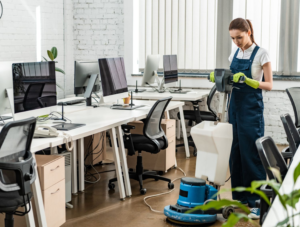Dirty air ducts can contain harmful contaminants and microorganisms like pet dander, mildew and mold spores. These particles can trigger or aggravate respiratory problems.

The cleaning process involves spraying high-pressure hot steam or detergents into the ductwork to liquefy debris and contaminants. A vacuum system then sucks the loosened material away. Contact Air Duct Cleaning Salt Lake City for professional help.
While furry family members bring joy and love into homes, they also shed their fur, skin, and dander. This natural shedding is what causes many people to suffer from pet allergies, which are characterized by itchy eyes and nose, runny nose, coughing, wheezing, and hives. While regular vacuuming, changing your air filters, and using an air purifier with a high-quality HEPA filter can help alleviate some of these symptoms, it’s important to have your ductwork cleaned as well.
Air ducts serve as reservoirs for pet dander and can trap it along with other allergens in your HVAC system, causing blockages over time. The dander then circulates throughout the home, irritating the nose and throat of allergy sufferers, while contributing to the growth of mold and increasing energy consumption.
Professional air duct cleaning removes pet dander from the interior of your ductwork, improving indoor air quality and HVAC efficiency. While it’s important to vacuum and change your filters regularly, you should have your ductwork cleaned by a professional at least once every two years in order to maintain optimal indoor air quality.
The proteins in animal dander trigger asthma symptoms, which can range from wheezing, chest tightness, and shortness of breath to full-blown attacks. These particles can be found on surfaces throughout the house, and they’re particularly persistent in hard-to-reach areas like ductwork.
It’s important to note that while pet dander can trigger asthma, other types of allergens can as well, including pollen, mold, and dust mites. Those with asthma should consult with their doctor to determine the best strategy for controlling their symptoms, which may include medication or allergy shots.
If you have pets, it’s especially important to make sure that your home’s ductwork is clean. Getting your ducts cleaned on a routine basis helps to reduce pet dander, which can help reduce allergy and asthma symptoms in your family. If you’re interested in a professional air duct cleaning service, enter your zip code below to get matched with top-rated pros near you! It’s free, fast, and easy! You’ll be on your way to a cleaner, healthier home in no time!
Water Damage
Water damage in your air ducts may lead to mold and fungus growth that affects the quality of air throughout your home. Fortunately, it’s possible to reduce the likelihood of such contamination through proper ventilation and air duct cleaning.
The first thing you should do is to find and eliminate the source of the water leakage. You can also take steps to reduce humidity by installing a dehumidifier in the crawlspace or attic where the air ducts are located. Then, if necessary, you can replace the ductwork with new insulation that will control the temperature and humidity levels of these areas.
After removing the source of the water leakage and addressing any structural problems, it’s important to have your ductwork cleaned. Dirty ductwork is a perfect environment for the development of mold and other microorganisms that can cause respiratory complications, such as coughing and wheezing. Moreover, water damage can also increase the amount of dust that is discharged from the ducts, which can further aggravate any respiratory conditions and allergies.
When choosing an air duct cleaning service, be wary of advertisements for “$99 whole house specials.” It is recommended that you get your air ducts cleaned every 3-5 years to maintain the best indoor quality of air. Make sure to hire a professional who uses specialized equipment and follows industry standards for air duct cleaning. Make sure that the company will provide a thorough visual inspection of the entire air duct system to ensure that all sections are clean.
Air duct cleaning professionals typically use high-strength vacuum cleaners to dislodge and collect any debris that is caked inside of the ductwork. This includes dirt, dust, and pet dander. However, it’s important to keep in mind that these professionals may accidentally dislodge contaminants, such as mold spores, into the living area of your home. If these spores are inhaled, they can further exacerbate any existing breathing problems and trigger allergic reactions in the residents of your home. Also, excessive use of the rotary brushes could tear the ductwork and introduce moisture into the ducts, which can lead to water damage and increase the chances for mold and other microorganism growth.
Smoke Damage
Smoke damage from fires or cigarette smoking can affect the quality of your indoor air. Smoke particles can be deposited on walls, ceilings and furniture. It can also contaminate fabrics and carpets with harmful carcinogens. If you live in a home that has been affected by smoke, it is a good idea to have your ductwork cleaned regularly to avoid spreading the odors.
Soot is a thick, black substance that can clog your airways. It can also corrode metal surfaces and weaken wood. When smoke reaches the HVAC system, it can leave behind a lingering odor that is carried throughout the house. In addition, it can irritate the respiratory tract and cause other health problems. You can test for smoke damage by inspecting your home and observing the following signs.
If you suspect you have smoke damage, you should contact a professional cleaning service. They have the tools and expertise to clean and restore your ductwork. They can also identify any areas that need repair or replacement. In addition to cleaning ducts, they can clean and disinfect the HVAC system to restore it to peak performance.
Biological contaminants in ducts can be caused by mold, bacteria and other organisms that thrive in moist, dark conditions. Those organisms can then be distributed throughout your home by the airflow from your heating and cooling system. The best way to prevent this is by controlling moisture, making sure that all components of the air handling system are in good working order and by removing standing water from drain pans under cooling coils.
Another source of contamination is animal dander. This can build up in your ductwork over time and spread through the house when the air conditioning system is running. This can aggravate allergies, auto-immune disorders and asthma.
The best way to prepare for a duct cleaning is by clearing out all vents and ensuring the technician can access them easily. It’s important to schedule the appointment during a time when you can be home. This will give you an opportunity to ask the technician questions about the process. You should also make sure that pets and children are crated or put in daycare during the appointment.
Mold
Mold requires a specific environment to grow, and it thrives in dark and damp areas such as air ducts. Mold spores are swept into air vents and blown out into the home, where they can aggravate respiratory problems and trigger allergies in people who have them.
Mold growth can also be a sign that your air ducts need cleaning. Symptoms of mold in your ductwork include musty smells and allergy symptoms, especially wheezing and coughing. If you notice any of these symptoms, you should consider scheduling an appointment for a professional inspection and duct cleaning to eliminate the problem.
To help reduce the risk of mold and other pollutants from spreading during air duct cleaning, many companies may use a chemical biocide to kill germs and prevent future biological growth. If you allow them to do this, be sure you understand the pros and cons of this approach, and make sure the company is using a biocide approved for air duct cleaning and applying it strictly according to label directions.
The EPA also warns that some types of mold, including Stachybotrys chartarum (black mold), can be spread through air ducts during cleaning. Black mold, in particular, can cause serious and often dangerous health problems, such as irritated eyes, nose, and throat; headaches; and dizziness. People with respiratory conditions, auto-immune disorders, or asthma are at particular risk for health issues related to black mold.
You should also be aware that mold spores are not always easily visible, and may hide in nooks and crannies. Taking the time to shine a flashlight through your vent openings and looking for signs of moisture or black specs can help you spot these spores and be proactive in getting them cleaned.
If you suspect mold is present in your air ducts, a qualified professional can conduct a thorough inspection and clean out the contaminated areas. They can then apply an EPA-approved mold inhibitor to protect against future contamination.
Depending on your situation, you might need to have an entire system of air ducts cleaned or just one room. In either case, you should ask the company how much it will cost to do this. Most reputable cleaning services will be able to give you an estimate based on the number of registers or vents that need to be cleaned, and how large your home is.


